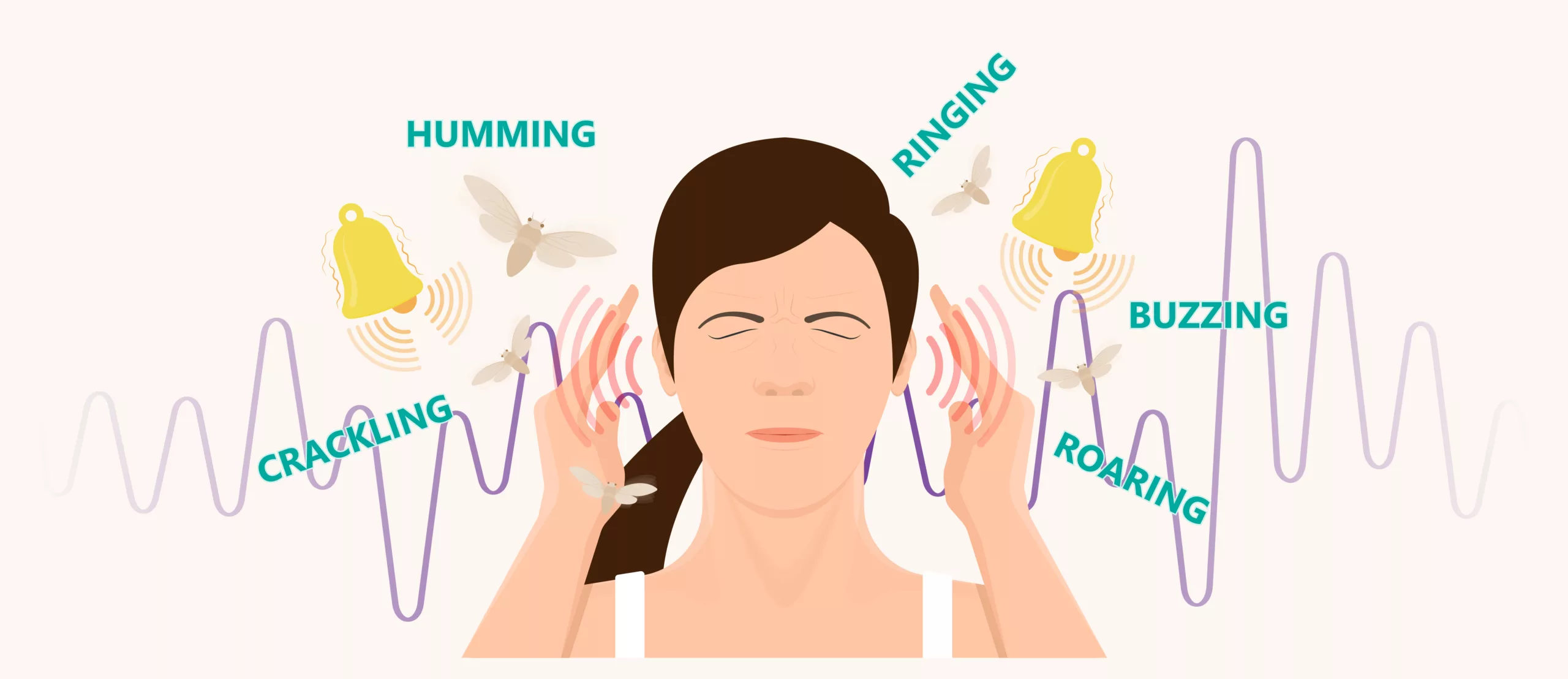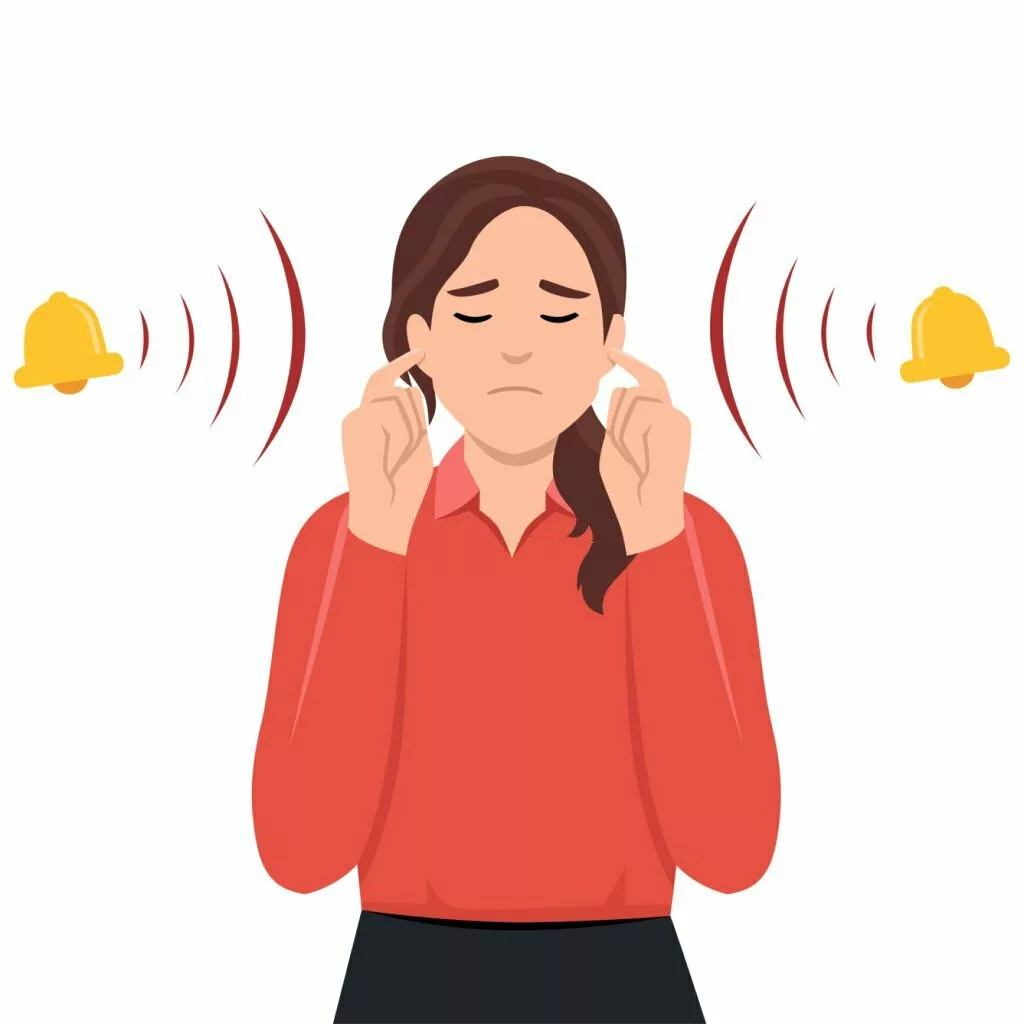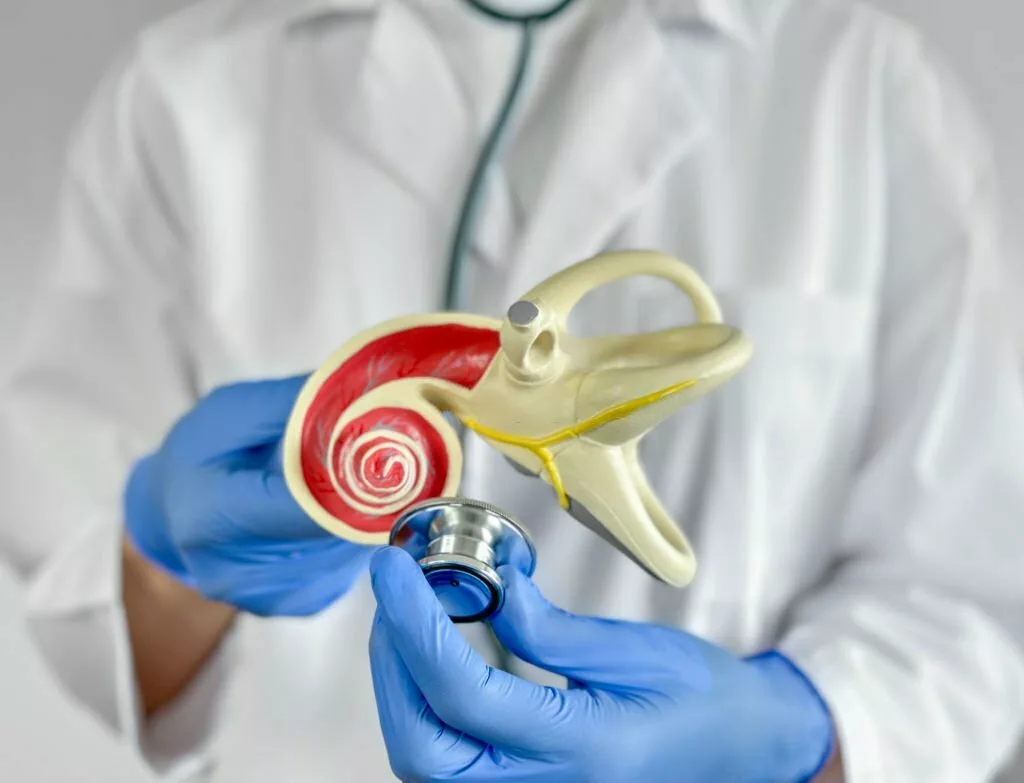Pulsatile Tinnitus (PT) is a condition in which a person can hear his own blood circulating around his ears due to an underlying disease. It is emotionally exhausting and can lead to depressive symptoms. Diagnosing and treating the underlying disease is the best way to eliminate pulsatile tinnitus. Various interventions, such as sound generators and CBT, can achieve symptomatic relief.
What is Pulsatile Tinnitus?
Pulsatile tinnitus is a rhythmic sound heard in the ear, typically in sync with the heartbeat.1Cummins, D. D., Caton, M. T., Shah, V., Meisel, K., Glastonbury, C., & Amans, M. R. (2022). MRI and MR angiography evaluation of pulsatile tinnitus: A focused, physiology‐based protocol. Journal of Neuroimaging: Official Journal of the American Society of Neuroimaging, 32(2), 253–263. https://doi.org/10.1111/jon.12955 It is mostly caused by some cardiovascular pathology.
Unlike other tinnitus, pulsatile tinnitus has a physical source of sound that is amplified and picked up by the ears. It is the sound of circulating blood.

Pulsatile vs. Non-Pulsatile Tinnitus
Non-pulsatile tinnitus is almost always subjective. It is more common than pulsatile tinnitus. Conditions like middle ear infections, presbycusis (age-related hearing changes), wax impaction in the ear, and neurodegeneration cause it. In pulsatile tinnitus, the patient’s heartbeat repetitively synchronizes with auditory perception. Cardiovascular pathologies most commonly cause this phenomenon.
All auditory perceptions except pulsatile tinnitus are non-pulsatile tinnitus. Less than 10% of people present with this condition.2Pegge, S. A. H., Steens, S. C. A., Kunst, H. P. M., & Meijer, F. J. A. (2017). Pulsatile tinnitus: Differential diagnosis and radiological work-up. Current Radiology Reports, 5(1). https://doi.org/10.1007/s40134-017-0199-7
Symptoms of Pulsatile Tinnitus
The most common symptom of PT includes hearing a whooshing or swooshing sound in the ear that is synchronized with the person’s heartbeat or pulse. It most commonly occurs due to the rapid flow of blood through the arteries or veins located around the ear. When the heart rate increases, the sound of tinnitus increases with it. It is like hearing your own heartbeat.
Since the sound is not coming from an external source, it is unsettling for the person experiencing it. In some cases, the noise becomes extremely annoying and debilitating. People suffering from tinnitus are more likely to suffer from depression and anxiety.3Hackenberg, B., Döge, J., O’Brien, K., Bohnert, A., Lackner, K. J., Beutel, M. E., Michal, M., Münzel, T., Wild, P. S., Pfeiffer, N., Schulz, A., Schmidtmann, I., Matthias, C., & Bahr, K. (2023). Tinnitus and its relation to depression, anxiety, and stress—A population-based cohort study. Journal of Clinical Medicine, 12(3), 1169. https://doi.org/10.3390/jcm12031169
Symptoms of PT are more common at night due to the decreased masking effects of external sounds in quiet surroundings. For some individuals, the whooshing sounds come and go, but for others, they are constant and hinder their daily lives.

Intermittent Pulsatile Tinnitus
When the noises associated with pulsatile tinnitus are inconsistent, i.e., they come and go, we call it intermittent PT. For example, increased blood pressure can result in pulsatile tinnitus in some people during exercise. After exercise, when the blood pressure goes down to normal, tinnitus settles.4Chen, S., Yang, X., Jiang, Y., Wu, F., Li, Y., Qiu, J., Tong, B., & Liu, Y. (2023). Associations between physical activity, tinnitus, and tinnitus severity. Ear and Hearing, 44(3), 619–626. https://doi.org/10.1097/aud.0000000000001306
Causes of Pulsatile Tinnitus
The causes can be broken down into vascular and non-vascular categories. Vascular pathologies can be further divided into arterial and venous problems. Arterial pathologies are more common. Some important conditions that lead to pulsatile tinnitus are as follows:
Vascular Causes
Uncontrolled Hypertension
When blood pressure is raised, there is more forceful blood flow in the arteries, which leads to the hearing of whooshing and thumping sounds.5Figueiredo, R. R., Azevedo, A. A., & Penido, N. D. O. (2016). Positive association between tinnitus and arterial hypertension. Frontiers in Neurology, 7. https://doi.org/10.3389/fneur.2016.00171 Stress, alcohol, and caffeine can make blood pressure worse and can be precipitating factors.
Atherosclerosis
The buildup of cholesterol in the arteries causes the formation of plaques that block the channels and lead to turbulence in blood flow. This turbulent blood flow in atherosclerosis can lead to vascular tinnitus.6Yüksel, F., Karataş, D., Türkdoğan, F. T., & Yüksel, Ö. (2018). Increased atherosclerosis correlates with subjective tinnitus severity. Indian Journal of Otolaryngology and Head and Neck Surgery: Official Publication of the Association of Otolaryngologists of India, 70(1), 119–124. https://doi.org/10.1007/s12070-015-0845-4
Irregular Blood Vessels
When blood flows through damaged vessels in the brain or around the ear, a whooshing sound can be heard.
Paragangliomas
Paragangliomas are neuroendocrine tumors that form near the carotid artery, along nerves of the head and neck, and in some other parts of the body. Tympanic paragangliomas (glomus tumors) are pulsatile masses present on the medial side of the tympanic membrane. These tumors release extra adrenaline or noradrenaline, which causes symptoms, including tinnitus.
Idiopathic Intracranial Hypertension (IIH)
It is a disorder related to high blood pressure in the brain due to venous pathology. It also results in PT.
Non-vascular Causes
Anemia
Anemia is a condition in which the body has less than the required number of normal circulating red blood cells. In anemia, blood flow is increased, which can result in pulsatile tinnitus.
Middle Ear Tumors
Small tumors in the middle ear can also lead to tinnitus. This occurs because the tumor’s blood supply is amplified and heard by the ear.
Other Ear Pathologies
- Otosclerosis
- Otitis media
- Labyrinthine fistula
Hyperthyroidism
Hyperthyroidism is a condition in which the concentration of circulating thyroid hormone increases. This increases blood flow, which in turn leads to pulsatile tinnitus.
Pregnancy
Hypertension during pregnancy is the cause of PT. However, pregnancy hormones, especially progesterone, can sometimes also cause it. In most cases, it disappears after childbirth when the hormones settle.
Migraine and Pulsatile Tinnitus
Pulsatile tinnitus is a complication of migraine. One theory suggests that migraine itself alters the blood vessels in the head, leading to Pulsatile tinnitus. A study in 2016 found that treating migraine symptoms also treated PT in 11 out of 16 individuals.7Weinreich, H. M., & Carey, J. P. (2016). Prevalence of pulsatile tinnitus among patients with migraine. Otology & Neurotology, 37(3), 244–247. https://doi.org/10.1097/mao.0000000000000968
Diagnosis of Pulsatile Tinnitus
When a person with pulsatile tinnitus symptoms presents to the doctor, the first step is a detailed medical history and review of the symptoms. A thorough history answers the following questions:
- Whether the tinnitus is bilateral or unilateral?
- Is it pulsatile or non-pulsatile?
- What are the symptoms, onset, aggravating and relieving factors, duration, and disease severity?
- How loud is the tinnitus? This helps establish differentials. For example, very loud, unbearable tinnitus might be due to arteriovenous malformation.
- A family history of tinnitus can raise concerns about autoimmune vasculitis like Takayasu.
- A history of otologic findings, such as hearing loss, otitis media, vertigo, and head and neck surgery, is also important for making differentials.
Clinical Examination:
The next step is clinical examination, which involves listening to the heart, neck, and head with a stethoscope. If the examiner can hear the sound, it is called objective pulsatile tinnitus. If not, it is called subjective pulsatile tinnitus.

Head & Neck Examination:
Pneumatic otoscopy, tuning fork tests, and cranial nerve examination are performed. The findings of these examinations can help decide whether a vascular or non-vascular pathology is present. The differentials include paragangliomas, otitis media, otosclerosis, etc.
Cardiac Examination:
A cardiac examination can help in ruling out or identifying causes like hypertension, carotid bruit, and aortic stenosis. It also helps establish whether the tinnitus is synchronous with the heartbeat. On palpation, thrill and other cardiac abnormalities should be carefully checked. On palpation, if the compression of arterial structures improves the symptoms, the pathology is most likely to be arterial. Valsalva maneuver reduces the symptoms if the cause is venous.
After that, the doctor determines whether the tinnitus is in line with the heartbeat. For that, the doctor will test the hearing and might perform tympanometry, a process to see whether the pulse in the ear is aligning with the heartbeat.
Diagnostic Tests for Pulsatile Tinnitus
The doctor will order other tests to find the underlying cause of pulsatile tinnitus. Some of these tests are as follows:
- Angiography — It uses contrast material to examine the blood vessels.
- MRA (Magnetic Resonance Angiography) — It checks the problems in head and neck vessels.
- MRI (Magnetic Resonance Imaging) — A doctor might order a neck and ear tissue examination to find the problem.
- Doppler Ultrasound — This will assess blood flow in the vessels of the neck.
- CT Scan — It produces a 3D image of the head and neck.
- HRCT (High-Resolution CT) creates detailed images of the blood vessels and other parts of the head and neck. It can be ordered to check for sinus wall abnormalities.
Management & Treatment of Pulsatile Tinnitus
PT can be managed in the following manner:
Treating the Underlying Cause
Pulsatile tinnitus is not a disease in itself but a manifestation of some vascular or nonvascular pathology occurring in the body. The best way to treat pulsatile tinnitus is to treat that underlying disease. For example, if pulsatile tinnitus occurs due to hypertension, medications to control hypertension (anti-hypertensives) will lead to control of pulsatile tinnitus. Similarly, if the underlying pathology is anemia, atherosclerosis, or hyperthyroidism, doctors must treat them first. In most cases, the pulsatile tinnitus will settle.
Symptomatic Relief for Tinnitus
Sometimes, the underlying disease is not recognizable even after elaborate investigations. In such cases, a person can do some interventions to control and manage the debilitating effect on their daily life.
Sound Generators
These devices mask tinnitus by producing sounds in the ear, such as rain or showers.
Relaxation Techniques
A sound therapist can recommend stress relaxation techniques that can help reduce the negative emotional reaction to the debilitating effect of tinnitus.
Counseling
People also benefit from mental therapies like Cognitive Behavioral Therapy (CBT)8Fuller, T., Cima, R., Langguth, B., Mazurek, B., Vlaeyen, J. W. S., & Hoare, D. J. (2020). Cognitive behavioral therapy for tinnitus. The Cochrane Library, 2020(1). https://doi.org/10.1002/14651858.cd012614.pub2 and Acceptance and Commitment Therapy (ACT).
Environmental Devices
You can also use a device that creates a background environmental sound instead of sound generators in the ear.
Medications
If pulsatile tinnitus is related to infection or inflammation in the ear, medications like antibiotics or anti-inflammatory drugs may be used to resolve the underlying condition.
Lifestyle Changes
Reducing stress, maintaining a healthy diet, and avoiding substances like caffeine and nicotine can sometimes help reduce the severity of symptoms.
Conclusion
To sum it up, pulsatile tinnitus is an emotionally and mentally debilitating condition caused by underlying diseases. If not managed properly, it can hinder daily activities and have a negative impact on life quality. Prompt diagnosis of the underlying cause and symptomatic interventions go a long way.
Refrences
- 1Cummins, D. D., Caton, M. T., Shah, V., Meisel, K., Glastonbury, C., & Amans, M. R. (2022). MRI and MR angiography evaluation of pulsatile tinnitus: A focused, physiology‐based protocol. Journal of Neuroimaging: Official Journal of the American Society of Neuroimaging, 32(2), 253–263. https://doi.org/10.1111/jon.12955
- 2Pegge, S. A. H., Steens, S. C. A., Kunst, H. P. M., & Meijer, F. J. A. (2017). Pulsatile tinnitus: Differential diagnosis and radiological work-up. Current Radiology Reports, 5(1). https://doi.org/10.1007/s40134-017-0199-7
- 3Hackenberg, B., Döge, J., O’Brien, K., Bohnert, A., Lackner, K. J., Beutel, M. E., Michal, M., Münzel, T., Wild, P. S., Pfeiffer, N., Schulz, A., Schmidtmann, I., Matthias, C., & Bahr, K. (2023). Tinnitus and its relation to depression, anxiety, and stress—A population-based cohort study. Journal of Clinical Medicine, 12(3), 1169. https://doi.org/10.3390/jcm12031169
- 4Chen, S., Yang, X., Jiang, Y., Wu, F., Li, Y., Qiu, J., Tong, B., & Liu, Y. (2023). Associations between physical activity, tinnitus, and tinnitus severity. Ear and Hearing, 44(3), 619–626. https://doi.org/10.1097/aud.0000000000001306
- 5Figueiredo, R. R., Azevedo, A. A., & Penido, N. D. O. (2016). Positive association between tinnitus and arterial hypertension. Frontiers in Neurology, 7. https://doi.org/10.3389/fneur.2016.00171
- 6Yüksel, F., Karataş, D., Türkdoğan, F. T., & Yüksel, Ö. (2018). Increased atherosclerosis correlates with subjective tinnitus severity. Indian Journal of Otolaryngology and Head and Neck Surgery: Official Publication of the Association of Otolaryngologists of India, 70(1), 119–124. https://doi.org/10.1007/s12070-015-0845-4
- 7Weinreich, H. M., & Carey, J. P. (2016). Prevalence of pulsatile tinnitus among patients with migraine. Otology & Neurotology, 37(3), 244–247. https://doi.org/10.1097/mao.0000000000000968
- 8Fuller, T., Cima, R., Langguth, B., Mazurek, B., Vlaeyen, J. W. S., & Hoare, D. J. (2020). Cognitive behavioral therapy for tinnitus. The Cochrane Library, 2020(1). https://doi.org/10.1002/14651858.cd012614.pub2

